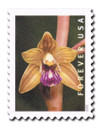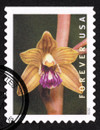
# 5447 - 2020 First-Class Forever Stamp - Wild Orchids (booklet): Hexalectris spicata
US #5447
2020 Hexalectris Spicata – Wild Orchids (Booklet)
- Pictures the crested coralroot orchid
- Part of the Wild Orchids set picturing nine orchid species native to the United States (one species shown twice)
Stamp Category: Definitive
Set: Wild Orchids
Value: 55¢ First Class Mail Rate (Forever)
First Day of Issue: February 21, 2020
First Day City: Coral Gables, Florida
Quantity Issued: 500,000,000
Printed by: Banknote Corporation of America
Printing Method: Offset
Format: Double-sided Booklets of 20
Perforations: Serpentine die cut 10 ¾ x 11 on 2 or 3 sides
Tagging: Phosphor tagged paper, block
Why the stamp was issued: To showcase the beauty and diversity of different species of wild orchids.
About the stamp design: Pictures a photograph by Jim Fowler of the crested coralroot orchid, a species that grows wild in the United States.
First Day City: The First Day of Issue Ceremony was held in Coral Gables, Florida, home to the headquarters of the American Orchid Society.
About the Wild Orchids set: Includes 10 stamps picturing photographs by Jim Fowler of nine different orchids (one species shown twice) native to the United States. Species include: the three birds (pictured twice), California lady’s slipper, crested coralroot, showy lady’s slipper, marsh lady’s tresses, eastern prairie fringed, greater purple fringed, grass pink, and yellow cowhorn orchids. These are all beautiful wildflowers that most people don’t get the opportunity to see. They’re all hard to find today.
History the stamp represents: Orchid species commonly bought in a store are known for large, colorful flowers that are impossible to miss. Wild orchids, on the other hand, can be relatively small and easily overlooked by inexperienced gardeners.
One unusual wild orchid native to the United States is Hexalectris spicata – the “crested coralroot” orchid. The orchid earned its name from the Greek Hexalectris, meaning “six rooster,” in reference to the six raised ridges on the lower flower petal. Spicate indicates that the flowers grow from a spike. The “coralroot” part of this orchid’s common name refers to the plant’s twisted thick, stem-like root system.
The crested coralroot orchid has no leaves and is unable to produce chlorophyll to feed itself. Instead, it relies on a special relationship with certain fungi to survive. This is called mycorrhiza and consists of the fungi attaching to the orchid’s roots to provide it with water and other essential nutrients. Without the fungi, the orchid would eventually wither and die.
The crested coralroot orchid usually grows in tall grass or leaf litter, so even when it flowers, it can blend in with its surroundings from a distance. However, when viewed up close, the plant’s purple- and magenta-striped flowers become visible and reveal the plant’s striking hidden beauty.
US #5447
2020 Hexalectris Spicata – Wild Orchids (Booklet)
- Pictures the crested coralroot orchid
- Part of the Wild Orchids set picturing nine orchid species native to the United States (one species shown twice)
Stamp Category: Definitive
Set: Wild Orchids
Value: 55¢ First Class Mail Rate (Forever)
First Day of Issue: February 21, 2020
First Day City: Coral Gables, Florida
Quantity Issued: 500,000,000
Printed by: Banknote Corporation of America
Printing Method: Offset
Format: Double-sided Booklets of 20
Perforations: Serpentine die cut 10 ¾ x 11 on 2 or 3 sides
Tagging: Phosphor tagged paper, block
Why the stamp was issued: To showcase the beauty and diversity of different species of wild orchids.
About the stamp design: Pictures a photograph by Jim Fowler of the crested coralroot orchid, a species that grows wild in the United States.
First Day City: The First Day of Issue Ceremony was held in Coral Gables, Florida, home to the headquarters of the American Orchid Society.
About the Wild Orchids set: Includes 10 stamps picturing photographs by Jim Fowler of nine different orchids (one species shown twice) native to the United States. Species include: the three birds (pictured twice), California lady’s slipper, crested coralroot, showy lady’s slipper, marsh lady’s tresses, eastern prairie fringed, greater purple fringed, grass pink, and yellow cowhorn orchids. These are all beautiful wildflowers that most people don’t get the opportunity to see. They’re all hard to find today.
History the stamp represents: Orchid species commonly bought in a store are known for large, colorful flowers that are impossible to miss. Wild orchids, on the other hand, can be relatively small and easily overlooked by inexperienced gardeners.
One unusual wild orchid native to the United States is Hexalectris spicata – the “crested coralroot” orchid. The orchid earned its name from the Greek Hexalectris, meaning “six rooster,” in reference to the six raised ridges on the lower flower petal. Spicate indicates that the flowers grow from a spike. The “coralroot” part of this orchid’s common name refers to the plant’s twisted thick, stem-like root system.
The crested coralroot orchid has no leaves and is unable to produce chlorophyll to feed itself. Instead, it relies on a special relationship with certain fungi to survive. This is called mycorrhiza and consists of the fungi attaching to the orchid’s roots to provide it with water and other essential nutrients. Without the fungi, the orchid would eventually wither and die.
The crested coralroot orchid usually grows in tall grass or leaf litter, so even when it flowers, it can blend in with its surroundings from a distance. However, when viewed up close, the plant’s purple- and magenta-striped flowers become visible and reveal the plant’s striking hidden beauty.














